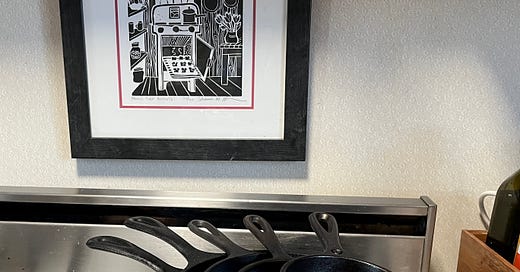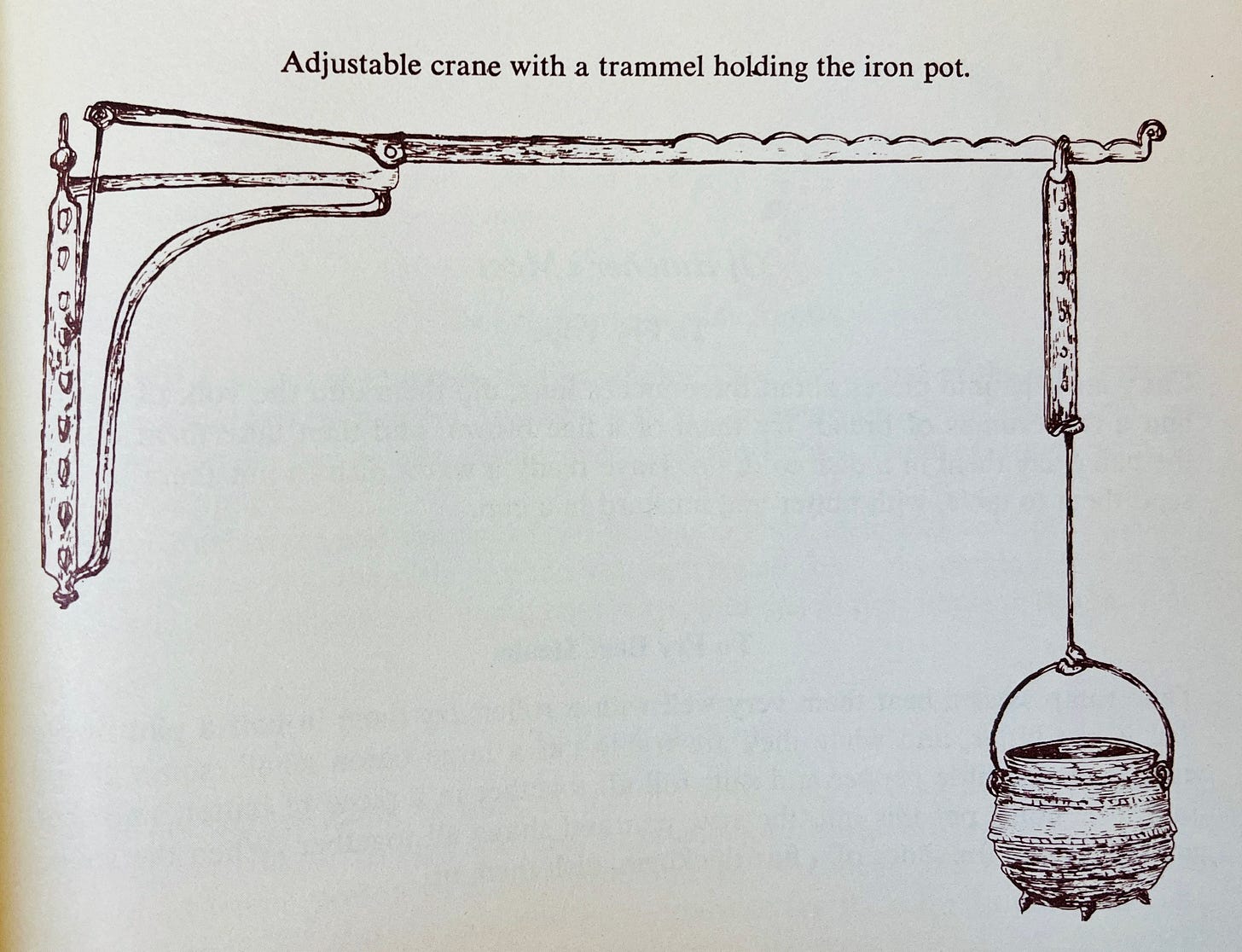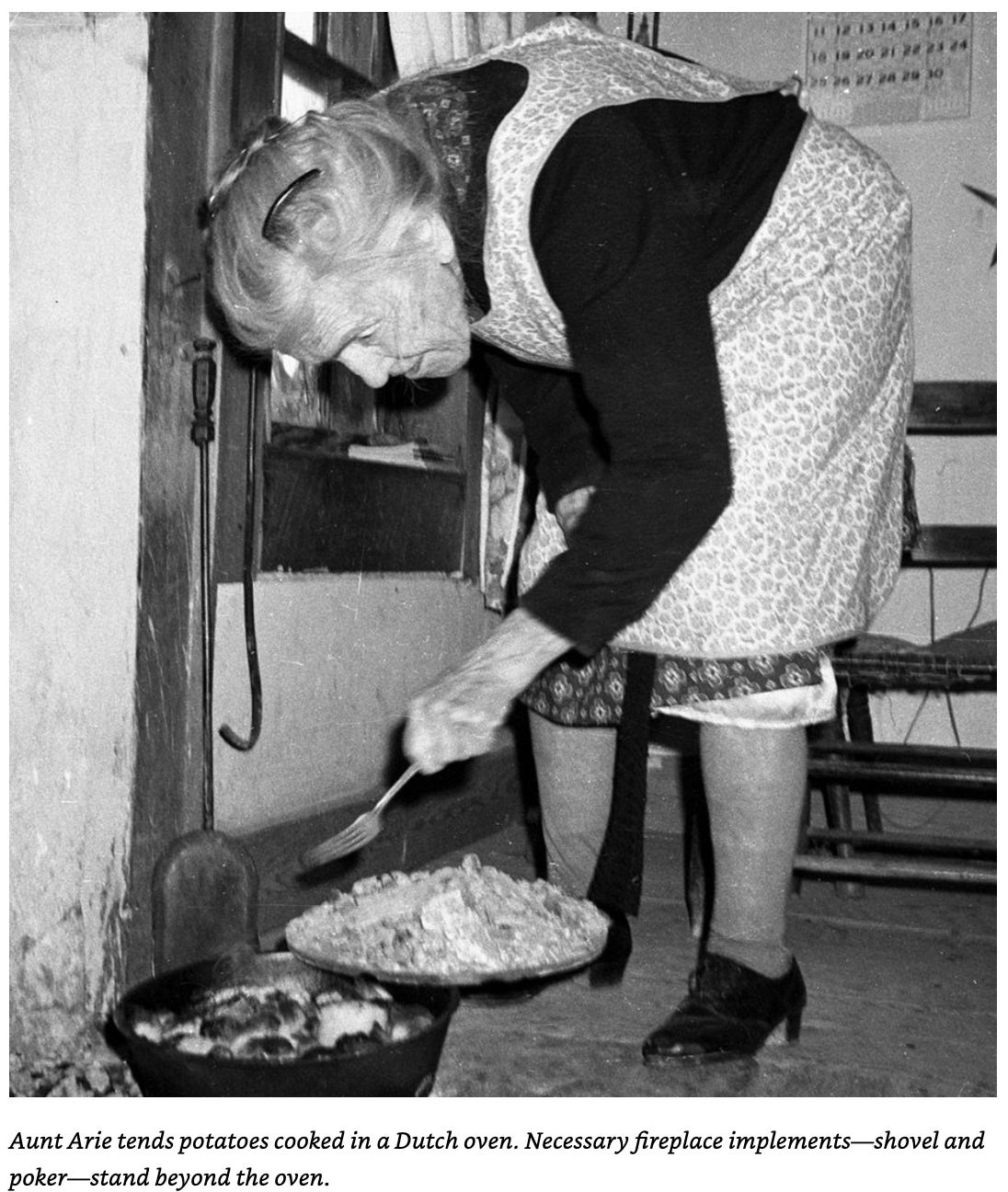# 227: I is for Cast IRON
A short history of cast IRON, how to pick a pan, season and maintain it, plus a recipe for cornbread cooked in a Dutch oven from Foxfire.
Perhaps the best thing about cast iron is that…it will likely outlive you.
—The Joy of Cooking
As I was casting around for ideas for the letter “I”, my cast iron cookware came to mind. If cared for cast iron can be, and often is, passed down through generations, but would you believe that some pieces are still in service at almost 200 years of age? After going down this rabbit hole, I wouldn’t be surprise to learn of even older pieces still in use.
Cast Iron Has Been Around a LONG Time
Cast iron was invented in China in the 5th century BC where it was poured into molds to make things like pots and pagodas.1 The first mention of a cast-iron kettle in English appeared in 679 or 680 though other metal vessels for cooking were also in use.2 By the 14th century cast iron was sporadically produced in Europe, in England about 1500, and in America when Falling Creek Iron Works (1619-1622) was established on the James River in Virginia.3
The iron cauldron was so important to rural life in England during the Middle Ages that it became a status symbol and a family inheritance. The earliest iron pots didn’t have legs because of the difficulty of attaching them without making holes causing leaks, but rather were balanced on stones or adjusted on logs. Some had iron legs wedged under the rim and others were suspended over the fire by an adjustable pot-crane.
Flat iron bake pans were common during the Scots wars of 14th century. Riders would carry small flat metal plates on their saddles, set them over a little fire of sticks and bake oat cakes from meal kept in linen bags mixed with water.4
Dutch ovens, bean pots, gem and corn cake pans, broilers and griddles if given proper care can last for centuries.
In Mountain Cooking, a collection of essays by John Parris published in 1978, I read of 41-year old Lawrence Wood who was cooking with the 140-year old black iron pot that belonged to his great-great-great grandmother.5 If still in use today the pot would be 187 years old and Wood would be 86. I hope both are still thriving.
Caring for Your Cast Iron
A new cast iron pan will come already seasoned but before using it you’ll need to give it a quick wash in soapy water, rinse, and then dry completely in a hot oven or on a stove-burner to avoid rust. While it is still hot-ish spread some oil over it (I use olive or avocado), wipe off the excess with a cloth or paper towel and it’s ready for its maiden voyage. Easy! You can find used cast iron at estate and garage sales, and thrift stores. If your reclaimed treasure needs to be restored there are video guides online to help like the one below.
Keeping the Blues Away
When red, blue, and purple foods such as cherries, berries, and red grapes and cabbage are cooked in cast iron their color can shift to blue due to anthocyanin pigments. Adding an acid like vinegar or lemon can help to chase those blues away.6 And, if you are anemic cast iron might even add a little boost to your system. 7
But It’s So Heavy!
Harold McGee writes in On Food and Cooking that cast iron’s thick heavy base “will absorb more heat and hold it longer than a similar aluminum pan.”8 It gives a steady even heat which is exactly what I want when I sauté onions and vegetables, bake skillet cornbread and even pie. Lifting heavy pots and pans may not always be possible for me but until the time comes when I can’t my cast iron contributes to my exercise program.
How to Pick a Pan?
Bee Wilson in Consider the Fork includes a series of questions that American engineer Chuck Lemme came up with about how to chose the right pan—whether that be cast iron or a another metal. Each question received a 1 to 10 rating and, after all was said and done, cast iron was the highest rated. Here are Lemme’s questions with Bee’s “translations.”9
Temperature uniformity (Will it even out heat spots?)
Reactivity and toxicity (Will it poison me?)
Hardness (Will it dent?)
Simple strength (Will it survive being dropped?)
Low stick rating (Will my dinner get glued on?)
Ease of maintenance (Will it wash easily?)
Efficiency (Does it conduct heat well vertically through the base?)
Weight (Can I lift it?)
Cost per unit (Can I afford it?)
My First Skillet
What kitchen gift would like for your wedding?
That’s what my mom asked me when I was to be married back in 1978. Without hesitation I asked for a big cast-iron skillet just like yours. Both my mom and grandmom cooked in cast-iron and I well remember our breakfasts of eggs and bacon, French toast and pancakes, lunches with grilled cheese and tuna melt sandwiches, and for supper many soups, stews, and fried chicken.
When Mom asked, Are you sure?, I’m pretty sure she was hinting that it would be OK for me to ask for a blender or even a Cuisinart which was a big ticket item and pretty new on the scene back then, but it was the skillet that I had set my heart on and I was very happy when I unwrapped a brand new Lodge 10” skillet at my bridal shower. Over the years, I’ve added more cast iron pieces to my collection including a grill pan, sauté pans and skillets, a chicken fryer, au gratin pans, and Dutch ovens both with and without legs, but after 46 years, that first skillet my mom gave to me, now well seasoned with memories, will always be my favorite.
Recipe: Cornbread Cooked in a Dutch Oven
From The Foxfire Book of Appalachian Cookery (revised 2019 edition)
A Few Other I’s for Your Eyes
Ice Bath - A mixture of ice and water used to chill a food or beverage rapidly although I recently learned that one of my relatives chills themself in an ice bath every day!
Ice box and ice box pies -Growing up we called the fridge the “ice box.” Ice box pies were named for the place they were kept cool.
Ice cream – With or without a la mode? How do you take your pie?
Icing - A sweet covering or filling such as buttercream or ganache; used for cakes and pastries; also known as frosting and not to be confused with Frosted Flakes.
Infuse - Bringing liquid into contact with food, herbs or spices so that the flavor transposes from one to the other…like coffee or tea!
Intuition - "A woman’s intuition is more accurate than a man’s certainty.” A favorite fortune cookie I received in my early 30s.
Irish Stew - A traditional mutton or lamb dish made by boiling well-salted and prepared chops with an equal quantity of onions and potatoes. Serve with a glass of dark stout and mop up the broth with plenty of Treasa’s Brown Bread, a recipe given to me on Inis Mor in Ireland’s Aran Islands.
What I’m Listening To
Cast Iron Skillet by Jason Isbell
Bake with Kate
Last Call to Register for the Savory Pasties and Handpies Virtual Workshop
May 5 at 11AM Pacific
We’ll be learning to make a hot-water crust and three different fillings—beef, pork, and vegetable—to fill it.
What I’m Reading
-Why the Cast-Iron Skillet Is the Only Kitchen Tool You Need by Jeffrey Steingarten, Vogue Magazine, April 21, 2014
I love Steingarten’s writing.
-Sharing Pie by Annette Laing, Non Boring History
Annette Laing, who writes the Substack Non-Boring History, and her family visited Pie Cottage last month and you can read about it below. Annette has labeled me a “folk philosopher,” something I’ve never been called before. Hmmm…it’s kinda growing on me.
Coming Up in May:
Tomorrow is the first day of May so be sure to say Rabbit Rabbit Rabbit before you get up for good luck all month long.
Next week watch for a very special post from NY Times best selling illustrator Stephanie Stilwell plus a sweet pie recipe from me.
Links to May Calendars
And finally, a gentle ask. If you like this newsletter, please let me know by leaving a comment. Paid subscriptions mean a great deal to me, too. For as little as $1.25 a week, which works out to $0.18 a day, you can help to support my work to bring this newsletter to you. I really hope that you feel that what you find here is worth it.
Lost Country Life by Dorothy Hartley. Pantheon Books (1979)
Mountain Cooking by John Parris. Asheville Citizen -Times Publishing Co. (1978)
The Inquisitive Cook by Anne Gardiner and Sue Wilson with the Exploratorium. Henry Holt and Company (1998)
Laboratory tests conducted by America's Test Kitchen found that an unseasoned cast-iron skillet leached significant iron into tomato sauce (10.8 mg/100 g) while a seasoned cast-iron pan leached only a small amount.
On Food and Cooking by Harond McGee, Scribner (2004)
Consider the Fork by Bee Wilson. Basic Books (2012)


















The picture of the woman tending the potatoes in the Dutch oven looks so much like my great grandmother. She work the same shoes, nylons, apron, everything. She was the best cook and always used cast iron.
I love that you included a photo for Aunt Arie, and the Foxfire recipe for cornbread. I live in Rabun County , GA, home of Foxfire. There is a museum of log buildings and lots of classes ongoing, including one frequently offered on wood stove cooking. I took a class there, and we baked pies on a wood stove! https://www.foxfire.org/